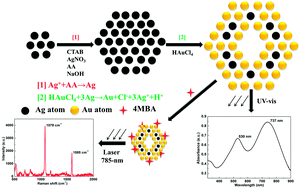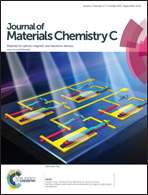Ag@Au hexagonal nanorings: synthesis, mechanistic analysis and structure-dependent optical characteristics†
Abstract
Well-shaped Ag@Au hexagonal nanorings (Ag@Au HNRs) were successfully synthesized with the assistance of Ag hexagonal nanoplates as structure-directing templates in a galvanic replacement route, and their optical characteristics were studied in detail. During the synthetic process, the morphology of the Ag@Au HNRs was found to be strongly depended on the dosage of HAuCl4 added into the template solution. Both the experimental and calculated absorption spectra showed that the red-shift of localized surface plasmon resonance (LSPR) peaks of the Ag@Au HNRs obeyed a modified Lorentz function with increasing dosage of HAuCl4 solution, which was also explained by the plasmon hybridization of the Ag@Au HNRs. Moreover, the surface-enhanced Raman scattering (SERS) characteristics of Ag@Au HNRs were investigated by using 4-mercaptobenzoic acid (4MBA) as a Raman reporter molecule. And the as-prepared Ag@Au HNRs exhibit excellent SERS performances with an enhancement factor ∼106, especially for the Ag@Au HNR prepared at 160 μl HAuCl4 solution due to its strongest plasmon electric-field enhancement. It reveals that the as-synthesized Ag@Au HNRs possess great potential for the application in ultrasensitive biosensors.


 Please wait while we load your content...
Please wait while we load your content...